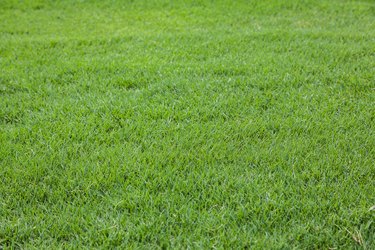
Sometimes, growing grass isn't about creating a beautiful landscape. Instead, it's about feeding livestock. In that case, you need high protein hay or high protein grass for cattle. The critical difference between grass and hay is when you cut it. You cut hay when it is dry, whereas you cut grass when it is green. Because hay is dry, it keeps longer and is also more nutrient-dense for livestock consumption.
Grass and Hay With the Highest Protein
Video of the Day
Does grass have protein? It does; however, some hay and grass types are better than others. One of the best types of grass for cattle and other livestock is Bermuda grass. Bermuda grass, which is also a favorite of homeowners trying to grow a beautiful lawn, is relatively high in grass protein. Its crude protein levels can be as high as 16 percent, and it has a total digestible nutrient content of 55 percent.
Video of the Day
That means that most of what your animals eat is utilized by their body to sustain life and promote growth. Among the best Bermuda grass for hay are Tifton 85, Russell, Coastal and Tifton 44. There are also several types of seeds that are good for hay and grazing animals. If you live in a hot, dry climate, try Orchard grass or Timothy grass. Orchard grass is best if you're also hoping to harvest seed.
Perennial ryegrass does very well in wetter conditions, and it does not need as much sun as Orchard or Timothy. It grows quickly with ample water but dies almost as fast in drought conditions. If your area is prone to occasional drought and is cooler and shadier, try red fescue. You can also buy fescue mix, which is a combination of red fescue and perennial ryegrass.
Hay Grass Types to Avoid
Unless you lock them in pens or stalls, you won't be able to stop cows or many other types of animals from grazing. It is instinctual for them and is programmed into their natural behavior. They'll eat whatever is available, so you must be careful to provide healthy grasses and hay on which to graze. Certain types of grass are less healthy for animals, particularly cattle and livestock. Some types are not nutrient-dense; while they won't harm the animals, they also won't help them and may cause them to eat less of the good types.
Other grasses and plants can cause harm. Lespedeza, alfalfa, clover and other legume grasses are not suitable for cows because they contain too much fiber. This fiber causes bloating and discomfort for the animals. In addition, avoid treating your grass with nitrates or nitrogen-based fertilizer, as those elements are also harmful to cattle and other livestock.
Protein and Cattle
Certain types of grasses have high protein content, which is essential for animals that graze, including cattle, horses and other types of livestock. Cattle especially need protein for various reasons, and protein works in cattle in much the same way it functions in humans and other mammals. Cattle use that protein to build and maintain muscle, enhance their neurological functioning and help them sustain their energy.
Interestingly, the cow rumen makes most of the protein cows need. The rumen is the cow's largest stomach compartment, and the microbial biome inside it converts other nutrients and energy sources into usable protein for the cattle. As you might expect, a healthy diet is necessary for this process to take place; without a healthy diet, the biome inside the cow's stomach isn't necessarily suitable for creating the amount of protein it needs. Protein-rich grass or hay is an essential component of that diet.